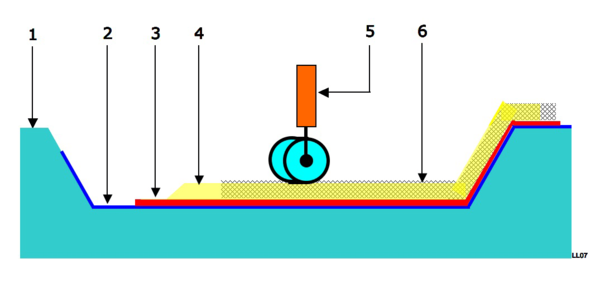Hand laminate
The hand laminate is a component made by hand from fiber-reinforced plastic using the simplest of tools . The size of the components ranges from small containers or molded parts to gliders or sports boats . In the associated manual laminate process , a negative form , more rarely a positive form, of the component to be manufactured is used, and the desired fiber fabric (for example glass fiber mats ) and the matrix (for example epoxy resin ) are placed in or on top of it.
negative form
The negative mold is coated with a release wax so that the finished component can be easily removed from the mold after it has hardened. The outermost layer is the gelcoat , which forms the outer visible layer and seals the laminate watertight. The gelcoat is applied directly to the release wax and is often colored with a color pigment. The fiberglass mats are soaked with the resin and placed in layers (laminate) in the mold by hand. After each layer, additional resin is applied as required until the fibers are soaked with the resin (the matrix) without air inclusions. There must be no air pockets, as these can reduce the strength overall and in certain directions ( isotropy ). Air inclusions are pressed out of the laminate with a hard roller or, in the case of the vacuum process, sucked out by negative pressure between the mold and a covering film. The component then has to harden. This is done either cold in the air or warm to hot in the hardening furnace , also known as a tempering chamber . The hot curing results in higher strengths and the curing process is a little faster.
|
Positive form
The positive form is a base body made, for example, of hard foam or a supporting framework encased with, for example, chicken wire. It usually remains in the interior of the component after it has been completed. Depending on the material of the mold and the resin, a separating layer is required so that the mold is not chemically attacked by the resin. With the positive form, the gelcoat is applied last as the outer layer, often rolled, brushed or sprayed as a varnish.
resin
Frequently used resins are unsaturated polyester resins (UP) (inexpensive) and epoxy resins (EP) (about twice as expensive). In the case of the resin, the correct mixing ratio of binder and hardener as well as good mixing of both components must be ensured. In sailplane construction, for example, the epoxy resin is taken from a dosing device, then stirred well and a small sample drop is taken from each mixed portion in order to be able to prove the strength of the individual mixtures. The processing time is between a few minutes and several hours, depending on the material.
literature
- AVK - Industrial Association for Reinforced Plastics eV (Hrsg.): Manual fiber composite plastics. Basics - Processing - Applications, 4th edition, Vieweg + Teubner Verlag, Wiesbaden 2010, ISBN 978-3-8348-0881-3 .
See also
Web links
- Glass fabric (layers, tapes) - lightweight solutions (accessed on August 7, 2020)
- Fiber composite materials introduction (accessed on August 7, 2020)
- Fiber composite material data (accessed on August 7, 2020)
- PLASTIC XTRA zero-eight-fifteen-work not working (accessed August 7, 2020)
- Characterization of fabric-reinforced individual layers made of carbon fiber reinforced plastic (CFRP) with the help of mesomechanical kinematics and structural dynamics tests (accessed on August 7, 2020)
